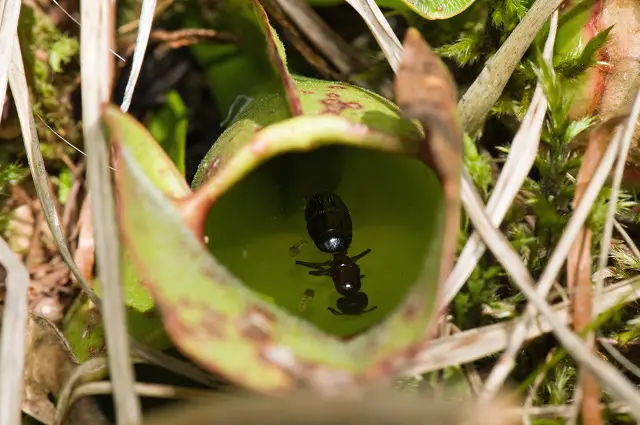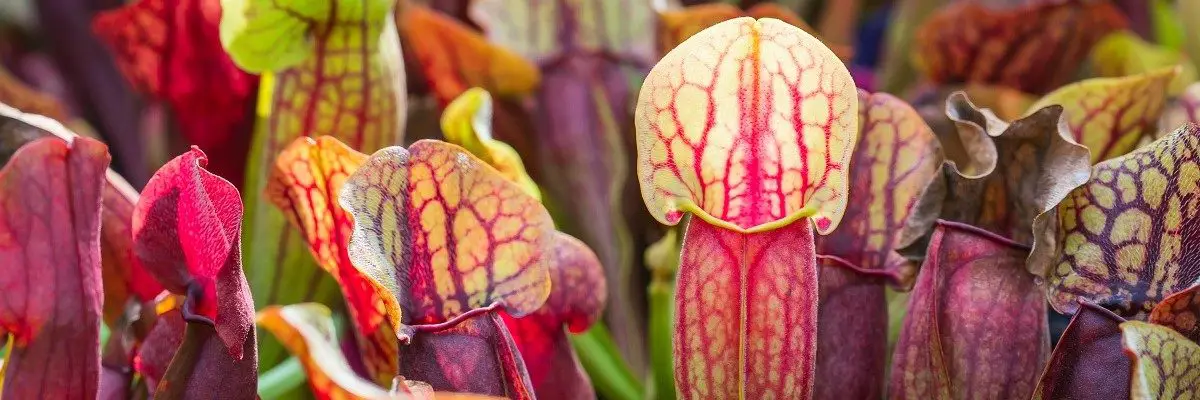Yes, the pitcher plant is a carnivorous plant that eats insects. The pitcher plants use altered leaves, called pitfall traps, to trap insects. These traps are vase-shaped and filled with nectar that acts as a digestive liquid. The plant’s enzymes digest the prey that gets trapped in the pitchers.
They usually have tall, narrow pitchers with bright colors and appealing scents that attract insects. If leaves are waxy or transparent, insects get trapped or tricked into dangerous positions. Laced with poisonous nectar, they become intoxicated. Trapped by the pitcher’s downward-facing hairs, the plant’s enzymes quickly digest those who slide and tumble down.
Pitcher plants refer to carnivorous plants in the families Nepenthaceae and Sarraceniaceae. Nepenthes pitcher plants typically climb and have rosettes of leaves known as tropical pitcher plants. More than 100 species of Nepenthes are found in the Nepenthaceae family.
Pitcher plants grow in sunny, open wetlands on the southern coastal plains of North America. Although one species extends into the upper Midwest and Canada, the greatest diversity can be found in Alabama, Georgia, and South Carolina. In recent years, Sarracenia populations have declined rapidly due to the draining of their habitats for housing developments. Many of them are now critically endangered.
How the Pitcher Plant Eats Its Prey
Flowers typically use nectar as an insect attractant. A pitcher plant attracts insects to its specialized, cylindrical leaves (the pitchers) with nectar, a sweet smell, and bright coloration. Unlike most insect traps, the pitcher does not contain any moving parts, so it is the perfect way to capture insects. It leaves form the perfect lure for insects.
Insects have difficulty climbing out because of the slippery interior surface and the hairs that are angled downwards inside the pitcher. This results in an extremally slick surface on which the insects need to walk to reach the nectar. They fall into the water at the bottom when they lose their balance. They will drown or exhaust themselves as they try to climb out of the water trap. Semitransparent openings on the pitchers intentionally mislead flying insects to confuse them and keep them from finding the real opening.
Sarracenias primarily prey on ants, flies, wasps, bees, beetle, slug, and snails. After an insect dies, special glands inside the surface release a digesting fluid that dissolves the insect. In this way, the pitcher can receive the nitrates it needs from the liquid, bug-rich slurry.
Why are Pitcher Plants Carnivorous?
Plants living in poor, nutrient-deficient areas evolved carnivorous behavior. These areas are swampy with highly acidic soil, consisting of low nitrogen and poor phosphorus levels. Nitrogen and phosphorus stored in small animals and insects can be the sole sources of nutrition for carnivorous plants in the poor environments in which they live.
Pitchers are part of a group of plants that have developed to capture insects. There are five major species. The plants trap their prey, which decomposes into mineral components absorbed into the leaf through bacterial decomposition or enzyme action. While Flypaper traps try to suffocate insects by adhering to them (sundew),
A Beartrap twists or wraps around its prey (Venus flytrap, Dionaea), a Bladder trap utilizes an underwater suction to pull food into a sack (Bladder), and a Cork Screw trap builds underground tubes through which prey can easily enter but have an extremally hard time trying to escape the actual corkscrew.

Habitat of the Pitcher Plant
North America is the native home of the pitcher. Pitcher plants are usually found within a horseshoe-shaped range that extends from eastern Texas to Florida and onto Newfoundland, Canada, then west to British Columbia. The plants live in all types of permanently moist habitats, including swamps, lake edges, riverbanks, boggy pine forests, fens, and low-lying areas. Pitcher plants can survive well in areas experiencing temporary flooding and submersion but cannot live in permanently flooded areas. As a result, they cannot tolerate long-term droughts.
A pitcher’s growth takes place over a season. After the bloom of April or May, a growing season lasts through the summer. As soon as the fall arrives, the plant goes into dormancy. Pitcher plants undergo a flush of growth in the spring, followed by a slumber summer and dormancy winter. Many pitchers die back when the plants have gone dormant in the fall. Pitcher plants can develop different-sized pitchers throughout the year and may have the largest fanciest pitchers when they go dormant in winter.
As a result of altered habitats or human presence in their native habitats, many pitcher plants are in danger of becoming extinct. It is common to find pitchers around water bodies where we build homes and farms. A majority of the pitcher plants’ natural range has been filled in and the water table artificially lowered by humans. According to estimates, over 97.5% of the pitcher plant’s original habitat in North America has disappeared since European settlement. This loss of habitat has significantly increased in the last 30 years.


